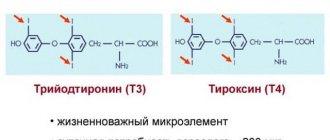Factors causing pathology
The occurrence of a crisis condition is associated with incorrectly chosen tactics for the treatment of toxic diffuse goiter or, as it is also called, Graves' disease. This is an autoimmune disease caused by rapid growth of the thyroid gland.
There are a number of other causes of thyrotoxic crisis that cause a life-threatening condition:
- Surgeries on the thyroid gland performed to eliminate diffuse goiter;
- Surgical extraction of teeth;
- Ether anesthesia, which is used during surgery;
- Radioactive iodine, used during the treatment of diseases associated with the thyroid gland;
- Incorrectly chosen dosage or duration of medication during treatment;
- Use of X-rays to treat the thyroid gland;
- Incorrect palpation of the thyroid gland.
Serious provocateurs of a crisis include the following conditions:
- Infectious pathologies associated with the respiratory tract;
- Problems with blood flow to the brain;
- The period of pregnancy and labor;
- Severe stress;
- Injury;
- Prolonged physical activity;
- Pulmonary embolism.
Clinical manifestations of thyrotoxic crisis occur mainly in the summer, late spring or early autumn.
The life-threatening condition is a consequence of treatment failure, which leads to hormonal imbalance.
Prevention
To reduce the risk of developing a thyrotoxic crisis in thyrotoxicosis, you should:
- avoid stressful situations;
- treat the underlying pathology;
- try to avoid intense physical activity;
- treat all existing chronic diseases.
Surgery for thyrotoxicosis or treatment with radioactive iodine can be performed only when the level of thyroid hormones in the blood returns to normal. If a patient suffers from decompensated thyrotoxicosis, he should not agree to operations at all if there is an opportunity to refuse them.
Characteristic symptoms
Manifestations and symptoms of thyroid crisis are associated with excessive concentrations of triiodothyronine (T3) and thyroxine (T4). Under their influence, in a state of crisis, the following pathological processes develop:
- Insufficiency of adrenal gland functionality;
- Increased synthesis of catecholamines;
- Activation of 3 systems: sympathetic-adrenal, hypothalamus and reticular formation of the brain.
The life-threatening condition has characteristic signs and symptoms that appear suddenly. In exceptional cases, a prodromal period may develop, when symptoms slowly increase.
There are 2 periods of crisis:
- Excitement (irritation of the sympathetic-adrenal system);
- Lethargy, the appearance of cardiovascular pathologies (cessation of compensation mechanisms).
Let's look at the symptoms of a crisis and emergency care, which is important to provide before doctors arrive.
- A febrile state in which body temperature rises to 39-40 degrees;
- Frequent pulse, reaching up to 200 beats per minute;
- Headache;
- Profuse sweating;
- Hands and feet tremble violently;
- The amount of urine excreted sharply decreases;
- Central nervous system disorders;
- Disorder of the gastrointestinal tract.
Symptoms confirming nervous system disorders require special attention. They are recorded in 90% of patients.
- Lethargy;
- Quick change of emotional background;
- Manic syndrome;
- Anxiety;
- Sleep disorders;
- Excitation;
- Confused consciousness;
- Severe weakness felt in the muscle tissue of the face and body.
Pathological changes in the cardiovascular system are manifested in the following signs:
- Increased blood pressure;
- Atrial fibrillation;
- Tachycardia;
- Dyspnea;
- Hard breath.
“Gastrointestinal” symptoms look like this:
- Lack of appetite;
- Nausea accompanied by vomiting;
- Spasmodic attacks in the abdominal area;
- Diarrhea.
Symptoms of a crisis
The development of thyrotoxic crisis occurs quickly - within several hours (in rare cases, the duration of development can be 2-3 days). In the progression of the process, two main stages can be distinguished: the period of excitation and the phase of progression of cardiac pathologies. The first stage is associated with the activation of the sympathetic-adrenal system, and the second stage is associated with the attenuation of compensatory mechanisms.
Signs of crisis are intensely manifested symptoms of toxic goiter of a diffuse type with an avalanche-like intensification. The following symptoms are typical: nausea, unstoppable vomiting, increased sweating, severe diarrhea leading to dehydration, muscle adynamia. Against this background, an indomitable fear of mortal danger arises.
The person’s appearance changes sharply: a hyperemic, mask-like face with a pronounced state of horror, eyes wide open with rare blinking. The injured person takes a specific position: spreading his arms and legs to the side, with his legs bent at the knees. The skin is moist and hot to the touch. You can hear rapid breathing (this is a sign of suffocation).
Symptoms of cardiovascular system disorders manifest themselves in the form of severe tachycardia (above 190 beats per minute), atrial fibrillation, and tachypnea. Acute heart failure often develops. The increase in blood pressure is determined by the severity of the attack. The development of heart failure is indicated by an increase in diastolic pressure.
Renal pathologies are clearly expressed in the form of a significant decrease in the frequency of urination, up to anuria (complete blocking of urine output). The critical condition is aggravated by acute hepatic atrophy.
The progression of the crisis leads to neurogenic and motor disorders. The following manifestations are possible: acute form of psychosis, hallucinations and delusions, confusion of consciousness followed by prostration and the onset of a coma. Mental lesions cause developing lethargy, loss of spatial orientation, and confusion.
Specifics of diagnosis and prognosis
Diagnosis of a crisis is based on the characteristic symptoms of the types of diseases that cause thyroid pathology. Possible provoking factors must be taken into account: the patient is in a state after surgery, an infectious disease, etc.
Diagnosis requires additional laboratory and hardware tests:
- Blood chemistry;
- Determination of blood sugar levels;
- ECG;
- Listening to heart sounds;
- Recording heart rate and blood pressure.
Failure to obtain emergency treatment during a thyrotoxic crisis will result in hallucinations, delusions, and acute psychosis. Then the excited state is replaced by lethargy and complete loss of space.
The importance of early treatment of thyrotoxic crisis , the diagnosis of which is based on clinical impression, cannot be overestimated. Before starting treatment, blood should be drawn to test thyroid function and determine cortisol levels, as well as a complete clinical blood count and routine biochemical tests. Cultures are indicated to detect infection. It is advisable to draw up a clear treatment plan to avoid unnecessary delay in specific therapy. The goals of specific treatment are: maintaining the basic functions of the body at the physiological level; inhibition of thyroid hormone synthesis; slowing the release of thyroid hormones; blockade of the effects of thyroid hormones in the periphery; identification and correction of provoking factors. You should strive to achieve all of these goals simultaneously.
Maintaining Basic Body Functions Adequate hydration with intravenous fluids and electrolytes is indicated to replace so-called insensible losses, as well as losses through the gastrointestinal tract. Additional oxygen administration is necessary due to increased oxygen consumption. During a crisis, hyperglycemia and hypercalcemia may occur; they are usually corrected with fluids, but in some cases specific therapy is required to reduce unacceptably high calcium and glucose levels. Fever is controlled with antipyretics and a cooling blanket. Acetylsalicylic acid should be used with caution or not at all, since salicylates increase free T) and T4 levels due to decreased protein binding. This consideration is rather theoretical, since no adverse effects have been noted with the use of acetylsalicylic acid. During thyrotoxic crisis, sedatives should be used with caution. Sedation depresses consciousness, which reduces the value of this parameter as an indicator of clinical improvement in the patient’s condition. In addition, it can cause hypoventilation.
Congestive heart failure is treated with digitalis and diuretics, although failure due to hyperthyroidism may be refractory to digitalis. Cardiac arrhythmias are treated with conventional antiarrhythmic drugs. Atropine should be avoided as its parasympatholytic effect may increase heart rate. In addition, atropine may counteract the effects of propranolol.
Intravenous glucocorticoids are prescribed in a dose equivalent to 300 mg hydrocortisone per day. The role of the adrenal glands in the pathogenesis of thyrotoxic crisis is unclear, but the use of hydrocortisone has been shown to improve survival. Dexamethasone has some advantages over other glucocorticoids, as it reduces the conversion of T4 to T3 in the periphery.
Inhibition of thyroid hormone synthesis Antithyroid drugs propylthiouracil (PTU) and methylmazole block the synthesis of thyroid hormones by inhibiting the organification of tyrosine residues. This action begins within an hour after administration, but the full therapeutic effect is not achieved even after several weeks. Initially, a loading dose of PTC is prescribed (900-1200 mg, and then 300-600 mg per day for 3-6 weeks or until a therapeutic effect is obtained (control of thyrotoxicosis). An acceptable alternative is the administration of methylmazole at an initial dose of 90-120 mg followed by 30-60 mg per day. Both drugs are administered orally or through a nasogastric tube, since their parenteral forms are not available. PTU has an advantage over methyl mazole: it inhibits the peripheral conversion of T4 to T3 and produces a therapeutic effect more quickly. Although these drugs inhibit synthesis again formed thyroid hormones, they do not affect the release of already accumulated hormones.
Slowing down the release of thyroid hormones The introduction of iodine preparations immediately slows down the release of thyroid hormones from the sites of their accumulation. Iodides can be given as strong iodine solutions (30 drops orally every day) or as sodium iodide (1 g every 8 to 12 hours as a slow intravenous infusion). Iodide should be administered an hour after a loading dose of an antithyroid drug to prevent the thyroid gland from using iodine during the synthesis of new hormone.
Blockade of the peripheral effects of thyroid hormones Adrenergic blockade is the mainstay of treatment for thyrotoxic crisis. In an extensive series of observations, Waldstein et al. (1960) noted an increase in patient survival when using reserpine. Guanethidine was subsequently demonstrated to be effective in alleviating the symptoms and signs of thyrotoxicosis due to sympathetic hyperactivity. Currently, the beta-blocker propranolol is the drug of choice. In addition to reducing sympathetic hyperactivity, propranolol partially blocks the conversion of T4 to T3 in the periphery.
Propranolol can be administered intravenously at a rate of 1 mg/minute, with careful increases in the dose of 1 mg every 10 to 15 minutes until a total dose of 10 mg is reached. The positive effects of the drug (control of cardiac and psychomotor manifestations of thyrotoxic crisis) are observed within 10 minutes. The lowest dose sufficient to control thyrotoxic symptoms should be used; if necessary, this dose can be repeated every 3-4 hours. The oral dose of propranolol is 20-120 mg every 4-6 hours. When administered orally, propranolol is effective for approximately 1 hour. Propranolol has been successfully used in the treatment of thyrotoxic crisis in children. Young children may require high doses of the drug (240-320 mg/day orally).
Usual precautions should be taken when prescribing propranolol to patients with bronchospastic syndrome and heart block. If it is used, a preliminary ECG study is carried out to assess conduction disorders. In patients with congestive heart failure, the beneficial effects of the drug (reduction in heart rate and some arrhythmias) should be compared with the risk of its use (inhibition of myocardial contractile function with beta-adrenergic blockade). Urbanic believes that the benefits of propranolol treatment outweigh the risks in this situation, but the author recommends pre-administration of digitalis.
When treating thyrotoxicosis or thyrotoxic crisis, propranolol should not be relied upon alone. Two cases of thyrotoxicosis occurring in patients who received seemingly adequate propranolol therapy for thyrotoxicosis are described. It is known that with a single or repeated oral dose of propranolol, its plasma level is very variable in controls and in patients with thyrotoxicosis. Treatment of thyrotoxic crisis should be quite flexible and individualized.
One of the authors recommends a gradual reduction in the dose of propranolol as the thyrotoxic crisis resolves. He believes that an objective assessment of the patient's condition may be difficult because propranolol masks the symptoms of hypermetabolism. In patients who have already received beta blockers, the symptoms of thyroid crisis may be masked, which carries the risk of late diagnosis of thyrotoxic crisis.
Alternative drugs to propranolol are guanethidine and reserpine, which also provide effective autonomic blockade. Guanethidine reduces catecholamine stores and blocks their release. When administered orally at 1-2 mg/kg per day (50-150 mg), it is effective within 24 hours, but its maximum effect may take several days. Toxic reactions are cumulative and include postural hypotension, myocardial decompensation and diarrhea. The advantage of guanethidine over reserpine is the absence of the pronounced sedative effect characteristic of reserpine.
The action of reserpine is aimed at reducing catecholamine reserves. After the initial dose (1-5 mg intramuscularly), the drug is administered every 4-6 hours at 1-2.5 mg. Improvement in the patient's condition can be observed after 4-8 hours. Side effects of reserpine include drowsiness, mental depression (this can be severe), cramping abdominal pain and diarrhea.
Identification and elimination of provoking factors A thorough assessment of the provoking factors of thyrotoxic crisis is carried out. Treatment of thyrotoxic crisis should not be delayed until these factors are identified; appropriate examination can be carried out as the patient’s condition stabilizes. The provoking factor is identified in 50-75% of cases.
Recovery After starting treatment, symptomatic improvement is observed within a few hours, primarily due to adrenergic blockade. Elimination of a thyrotoxic crisis requires the destruction of circulating thyroid hormones, the biological half-life of which is 6 days for T4 and 22 hours for T3. Thyrotoxic crisis can last from 1 to 8 days (average duration - 3 days). If standard methods of crisis control are unsuccessful, alternative therapeutic options may be considered, including peritoneal dialysis, plasmapheresis, and charcoal hemoperfusion to remove circulating thyroid hormones. After recovery from the thyrotoxic crisis, radioactive iodine therapy is the treatment of choice for hyperthyroidism.
Mortality If thyrotoxic crisis is untreated, the mortality rate approaches 100%. There is a reduction in mortality with the use of antithyroid drugs. The lowest mortality rate for thyrotoxic crisis over a 10-year period is reported to be 7%; its usual figure is 10-20%. In many cases, the cause of death is a preexisting disease. The main means of reducing mortality, of course, is to prevent the development of thyrotoxic crisis. Early recognition and timely treatment of this complication of hylerthyroidism gives the patient a better chance of survival.
Features of pre-medical actions
We have already mentioned that manifestations of thyroid crisis most often develop within 2-4 hours. In this case, the first urgent action should be to call an ambulance. Describe in detail to the dispatcher the patient’s condition and pronounced symptoms. Then begin providing first aid.
- Provide the patient with a comfortable position;
- Loosen or remove tight clothing;
- Provide free access of fresh air to the room;
- Measure body temperature and pressure;
- Assess your heart rate and breathing rate per minute.
An important task of first aid is to reduce high body temperature. However, aspirin cannot be used for this purpose! The temperature is reduced using traditional medicine: wiping with cold water, vinegar solution or alcohol.
Remember that a crisis is accompanied by gastric disorders, so it is important to anticipate the occurrence of vomiting. To prevent the patient from choking on his own vomit, place him on his side. Hold his head while vomiting. Then, rinse your mouth with clean water.
Drug therapy
After providing first aid, doctors urgently begin administering medications. Taking medications performs 3 tasks:
- Neutralization of the factor that provoked the dangerous condition;
- Maintaining the functionality of the body;
- Normalization of hormonal levels.
In case of a crisis caused by thyrotoxicosis, the algorithm for drug assistance is as follows:
- To slow down the production of thyroid hormones, drugs containing iodine are administered;
- To suppress the functionality of the thyroid gland, Mercazolil is used;
- A sodium glucose solution and prednisolone are administered to restore adrenal function.
- To relieve nervous tension, droperidol is administered by drip.
The specifics of therapy are selected based on the characteristics of the clinical manifestations of the pathology.
Preventive measures
Thyrotoxic crisis is a dangerous pathology that can be fatal. Therefore, compliance with preventive measures to prevent it is an important component of the treatment of thyroid diseases.
The following preventive rules will help you avoid such a dangerous condition.
- Antithyroid medications should be taken as prescribed by your doctor;
- Before surgery or initiation of therapeutic iodine treatment, the patient must achieve a euthyroid state.
Remember! Any hormonal imbalances require quick adjustments.
Thyrotoxic crisis is a severe complication of thyroid disease, in which excessive secretion of hormones occurs. A crisis may not only be a consequence of untreated goiter with hyperthyroidism (increased hormone production), but also become a manifestation of incorrect treatment tactics.
Causes
The immediate cause of the developing symptoms of thyrotoxic crisis is a sudden rapid increase in the blood level of thyroid hormones - triiodothyronine (T 3) and thyroxine (T 4). As a rule, this occurs with a long-term disease, as well as after surgery on the thyroid gland or against the background of the use of radioactive iodine for therapeutic purposes.
A thyrotoxic crisis can develop not only in a potentially severe patient, but also in a person with a monotonous course of the disease, if he has been exposed to some factors that activate the thyroid gland, causing a hormonal surge in the body. Such factors include physical and emotional overload, concomitant chronic diseases if they suddenly worsen, various medical procedures (including dental), and a rise in body temperature (for example, due to the flu). In women, thyrotoxic crisis can be triggered by pregnancy.
The release of thyroid hormones into the blood not only leads to an enhanced manifestation of their action. In response to this, the adrenal glands begin to actively work, releasing adrenaline and norepinephrine, known as stress hormones. The combined effects of these active substances determine such a great danger of thyrotoxic crisis for the patient. In addition, against the background of such high production of thyroid hormones, the patient soon develops adrenal insufficiency - the function of the adrenal glands is depleted. This can lead to death if medical assistance is not provided to the patient in time.
Symptoms
The onset of thyrotoxic crisis is always acute. As a rule, only a few hours, or a day at most, pass from the action of a strong provoking factor (for example, surgery) to the onset of symptoms of a crisis.
The patient becomes anxious, worried, his body temperature rises, his heartbeat increases, and his breathing quickens. Body temperature rises quickly and can reach 40–41 °C or more in 3–4 hours. At first, the patient is usually excited and actively complains about his condition; then consciousness may be impaired. Sometimes, against the background of a thyrotoxic crisis, hallucinations and psychosis develop - the patient becomes uncontrollable, does not respond to beliefs, and commits uncontrollable acts, including suicidal ones.
Among other symptoms of a crisis are trembling of the hands, which is noticeable from the outside and can gradually turn into convulsions; the appearance of disturbances in the heart rhythm (more often atrial fibrillation), a sharp increase in systolic blood pressure to 180–230 mm Hg. Art., nausea, vomiting, diarrhea. Due to the heavy load on the heart, heart failure may develop.
Sometimes the patient complains of weakness, it is difficult for him to raise his arms and walk; Often, against the background of a thyrotoxic crisis, yellowness of the skin and sclera and diffuse abdominal pain appear. If the kidneys are involved in the pathological process, the person’s urine output stops or decreases.
Externally, the patient at the beginning of a thyrotoxic crisis looks frightened, his skin is red, moist, and hot when touched. Then, as the adrenal glands become exhausted and the body becomes dehydrated, the skin becomes dry, lips crack, and the patient becomes lethargic and lethargic.
Why does thyrotoxic crisis develop?
Typically, only a small portion of the free hormones T3 and T4 is found in the blood. 99% of them are bound to plasma proteins, primarily thyroglobulin.
During a thyrotoxic crisis, too much T3 and T4 suddenly enters the blood while their connection with thyroglobulin decreases. In response to this, the adrenal glands begin to actively work, releasing adrenaline and norepinephrine, known as stress hormones. The combined actions of these active substances explain such a great danger of thyrotoxic crisis for humans. In addition, against the background of such a huge amount of hormones, the patient soon develops adrenal insufficiency - the function of the adrenal glands is depleted. The higher nervous system is activated - the subcortical centers of the hypothalamus and reticular formation. All this can lead to death if medical assistance is not provided to the patient in time.
At the same time, a thyrotoxic crisis can develop not only in a seriously ill person, but also during a completely normal course of the disease. But for this to happen, something extraordinary must happen.
What can start this process?
- injection of radioactive iodine into the patient (causes the breakdown of thyroid follicles) or exposure to x-rays,
- stress in patients with undiagnosed hyperthyroidism: myocardial infarction, surgery, trauma, sepsis, burns, nervous strain, physical activity, infectious diseases.
- physical and emotional overload.
- concomitant chronic diseases, if they suddenly worsen.
- various medical procedures (including dental).
- rise in body temperature (for example, against the background of the flu).
- exacerbation of existing hyperthyroidism due to the severity of the underlying disease.
- the appearance of thyroid hormones from outside, for example, through errors in dosage.
- in women it can be triggered by pregnancy.
Causes and symptoms of thyrotoxic crisis
As noted above, the main reason for the development of a crisis is medical errors. But in some cases, other factors may contribute to this, including:
- the patient skips taking hormonal medications;
- consumption of iodine-containing products or dietary supplements;
- tooth extraction;
- head or neck injuries;
- acute respiratory infections or acute respiratory viral infections;
- stressful situations;
- great physical activity.
Other symptoms also appear:
- rapid increase in body temperature to 39-41°C;
- increase in heart rate to 140-200 beats/min.;
- heavy sweating;
- heart rhythm disturbances;
- increased blood pressure;
- diarrhea;
- hysterics, confusion;
- severely decreased urination;
- trembling in hands;
- muscle weakness throughout the body.
Such a serious condition of the patient leads to a huge burden on the entire body and can cause dehydration and the development of pulmonary edema, heart and kidney failure. Therefore, the main task of loved ones is to provide first aid even before the doctors arrive.
What's happening?
The maximum exacerbation of the symptoms of the disease begins. The severity of the condition depends on the concentration of free thyroid hormones in the blood. As a rule, only a few hours, or a day at most, pass from the onset of a strong provoking factor (for example, surgery) to the onset of symptoms of a crisis.
The patient becomes anxious, worried, his body temperature rises, his heartbeat increases, and his breathing quickens. The temperature rises quickly and can reach 40-41 °C or more in 3-4 hours. The pulse rate usually ranges from 120 to 200 beats per minute, but in some cases it reaches 300.
At first, the patient is usually excited and actively complains about his condition; then consciousness may be impaired. The person is anxious, emotionally unstable (cries, shows aggression, laughs), hyperactive and unfocused in behavior. Sometimes, against the background of a thyrotoxic crisis, hallucinations and psychosis develop - the patient becomes uncontrollable, does not respond to beliefs, and commits uncontrollable acts, including suicidal ones. Many patients begin to experience panic, fear of loss of consciousness, death.
As the crisis progresses, this state is replaced by lethargy, apathy, emotional dullness, and extreme muscle weakness. The thyrotoxic form of myopathy is manifested by decreased tone and rapid fatigue of the muscles of the neck, scapular region, arms and legs, and, less commonly, the face and torso. Pain, involuntary twitching, convulsions, hypokalemic paroxysmal paralysis (paroxysmal severe muscle weakness) may be observed.
Sweating can be profuse, leading to dehydration due to insensible fluid loss.
Extreme muscle weakness may occur.
Other symptoms of a crisis include trembling of the hands, which is noticeable from the outside and can gradually turn into convulsions; the appearance of disturbances in the heart rhythm (more often atrial fibrillation), a sharp increase in systolic blood pressure to 180-230 mm Hg. Art., nausea, vomiting, diarrhea. Due to the heavy load on the heart, heart failure may develop.
Cardiovascular disorders are present in 50% of patients, regardless of the presence of previous heart disease. Sinus tachycardia usually occurs. Arrhythmias may occur, especially atrial fibrillation, but with the addition of ventricular extrasystoles, as well as (rarely) complete heart block. In addition to an increase in heart rate, there is an increase in stroke volume, cardiac output and myocardial oxygen consumption. As a rule, pulse pressure increases sharply.
Most patients with thyrotoxic crisis develop gastrointestinal symptoms. Diarrhea and hyperdefecation contribute to dehydration (dehydration of the body).
Lack of appetite, nausea, vomiting and cramping abdominal pain often occur. Jaundice and painful hepatomegaly may occur.
Sometimes the patient complains of weakness, it is difficult for him to raise his arms and walk; Often, against the background of a thyrotoxic crisis, yellowness of the skin and sclera and diffuse abdominal pain appear. If the kidneys are involved in the pathological process, the person’s urine output stops or decreases.
Externally, the patient at the beginning of a thyrotoxic crisis looks frightened, his skin is red, moist, and hot when touched. Then, as the adrenal glands become exhausted and the body becomes dehydrated, the skin becomes dry, lips crack, and the patient becomes lethargic and lethargic.
There are 3 stages of crisis development:
Stage 1 - mortality is up to 10% and is characterized by the following symptoms:
Sinus tachycardia or tachyarrhythmia with existing atrial fibrillation, heart failure,
Hyperthermia (increase in body temperature to 38-41C) with profuse sweating,
General weakness
Gastrointestinal symptoms: nausea, vomiting, diarrhea (leads to dehydration).
Neurological symptoms: tremor, restlessness, agitation, muscle weakness primarily in the upper parts of the shoulder girdle, bulbar palsy (damage to the cranial nerves),
Dehydration (dehydration).
Stage 2 is characterized by the following:
Stupidity with delirium, stupor, stupor, hallucinations, with temporal and spatial disorientation.
Stage 3.
The mortality rate is up to 50% and the basis is an unconscious state, the patient enters a coma. It is further divided into: stage 3a - mortality less than 50% and stage 3b - mortality more than 50%.
First aid algorithm for thyrotoxic crisis
If you suspect a thyrotoxic crisis, you must call an ambulance, measure the patient’s temperature, pressure, and pulse. It should be borne in mind that most medications when administered orally will not be effective. To provide some relief to the patient's condition, the following procedures are used:
- The fever can be reduced by placing the patient in a bath filled with cool water (25-30° C) for 10-15 minutes.
- Continue cooling; in hot weather, cover the patient with wet sheets. Turn on the air conditioner or fan.
- Periodically wipe the skin with wipes soaked in ethyl alcohol (vodka). As alcohol evaporates, it cools the body well.
- In cold weather, open the windows and cover the patient with bags of snow or ice.
- To prevent dehydration during diarrhea, give chilled water.
- If the patient was taking thyreostatic drugs in tablets before the crisis, a double dose can be given, taking into account the reduced absorption of the drugs. Do not forget, after the ambulance arrives, to inform the doctor about this.
Cooling measures continue until the ambulance arrives.
It is necessary to inform the arriving specialists about blood pressure, pulse rate, body temperature and other procedures performed.
Depending on the patient’s condition, emergency doctors can give intravenous injections of thyreostatics, sedatives, and antipyretics. The patient is hospitalized.
First aid for thyrotoxic crisis and its treatment
The patient is treated in the intensive care unit even before test results are received. Clinical recommendations during this period are aimed at reducing the production of iodine-containing hormones and restoring those body functions that were affected by intoxication. These problems are solved according to the following scheme:
- To suppress the synthesis of T3 and T4, the patient is prescribed thyreostatics. Begin with the use of large doses, which are gradually reduced.
- To reduce the activity of thyroid hormones, iodine-containing drugs are used.
- Glucocorticosteroids are used to restore adrenal function.
- An electrolyte solution is injected intravenously to normalize the water-salt balance.
- To prevent heart failure, cardiac glycosides and diuretics are used.
- Arrhythmia and tachycardia are relieved with beta-blockers, and agitation with tranquilizers.
With this comprehensive approach, the patient’s condition stabilizes after 4-6 hours. Further treatment is prescribed taking into account the symptoms: continue taking thyreostatic, antipyretic, sedatives, and corticosteroids. The levels of T3 and T4 in the blood are constantly monitored. A high-calorie diet is prescribed.
Treatment of thyrotoxic goiter
Thyrotoxic crisis is a real threat to the patient’s life. Therefore, if symptoms of this pathological condition occur, it is necessary to take the patient to the hospital.
When treating a crisis, the doctor pursues the following goals:
- Maintaining basic body functions;
- Inhibition of the synthesis and release of thyroid hormones;
- Reducing the effect of thyroid hormones on target organs;
- Identification and subsequent elimination of the provoking factor.
Maintaining basic body functions
As a result of excessive sweating, vomiting, and diarrhea, the patient experiences significant fluid loss, which is fraught with dangerous consequences. To correct this condition, the patient is given large volumes of fluids and electrolytes intravenously.
Arrhythmia is treated with antiarrhythmic medications, and congestive heart failure is treated with diuretics and cardiac glycosides. To combat progressive adrenal insufficiency, glucocorticosteroids are prescribed.
Inhibition of the synthesis and release of thyroid hormones
To suppress the synthesis of thyroid hormones, antithyroid drugs (Mercazolil, Tyrozol) are prescribed. Initially, a large dose of the drug is prescribed, and in subsequent days the dose is gradually reduced. The drug begins to act after an hour. However, the necessary therapeutic effect can be achieved only after a few days.
Slowing down the release of hormones can be achieved by administering iodine preparations. These medications may be prescribed by your doctor as drops to take orally or as intravenous infusions.
Reducing the effect of thyroid hormones on target organs
To eliminate rapid heartbeat, arrhythmia, anxiety, and psycho-emotional agitation, beta-blockers (Propranolol) are used. The positive effect of the drug is observed ten minutes after administration. To relieve psychoemotional agitation, the patient is prescribed tranquilizers.
When the treatment provided is not enough, they resort to methods such as plasmapheresis and peritoneal dialysis. This method allows you to quickly clear the blood of thyroid hormones.
After the start of active treatment, improvement in the patient's condition is noted within a few hours. However, it may take from two to eight days to completely eliminate the crisis, which is associated with prolonged circulation of thyroxine in the blood.
Grigorova Valeria, medical observer
7, total, today
( 201 votes, average: 4.71 out of 5)
Viril syndrome: forms, symptoms and treatment
Hypoplasia of the thyroid gland: symptoms and treatment










